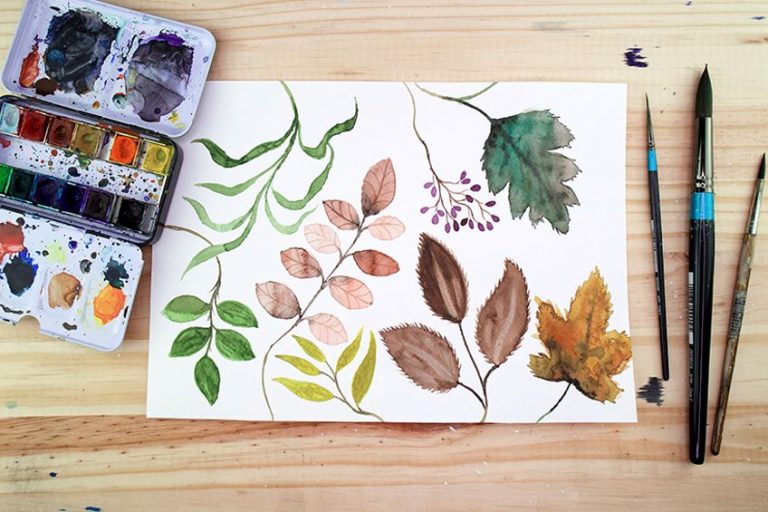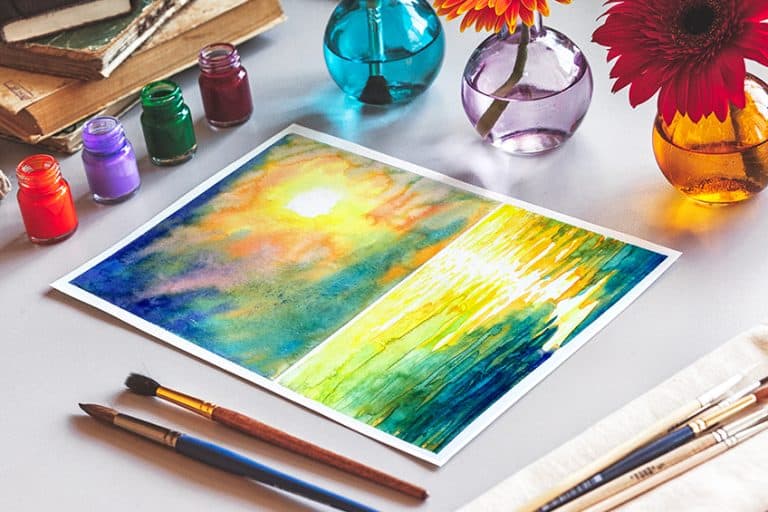Watercolor vs. Acrylic – The Difference Between Watercolor and Acrylic
Both watercolor and acrylic art have their appeal, and it is not a competition where one is better than the other. This article is more about discussing the differences to help you figure out which medium would suit you best. Both acrylics and watercolor are great options for beginners and even kids as they are water-soluble. Let us now dive into a more detailed look at acrylic vs. watercolor paints.
Table of Contents
What Is the Difference Between Watercolor and Acrylic Paint?
Paint must have a pigment, and all mediums have this fundamental ingredient. The difference is how the pigment is carried within the binding medium. This is what holds the pigment together, allowing you to use it on various surfaces. Both watercolor and acrylic paints are, however, water-soluble and can be thinned by adding water. Also, solvents are not required when cleaning up – you simply rinse it in some water.
Below, you will find a few differences when it comes to watercolor vs acrylic paints.
Watercolor Paint
Watercolor paints contain pigments in a natural gum arabic. The paint can also sometimes contain other ingredients like glycerin or preservatives that influence the color pigment and viscosity. Most watercolor binders are natural, but you can also get synthetic glycol that acts as a binder.
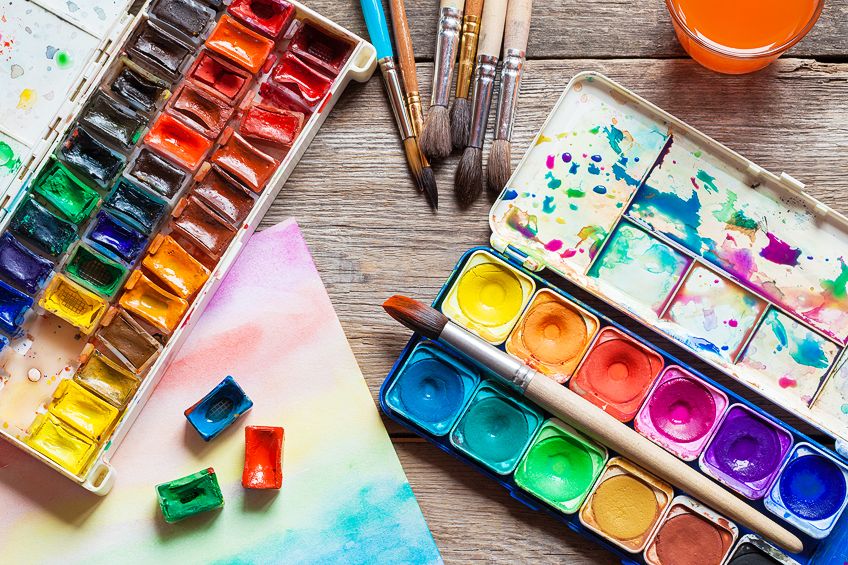
Types of Watercolor Paints
Watercolor paints come in pans and tubes. Using watercolor pans is easy, as you can begin painting straight away. When it comes to the watercolor tubes, the paint is a bit more saturated and works great for large areas and washes. Also, if the acrylic paint dries, you can simply add a little water to use it again.
Paint Transparency: Watercolors
Watercolors come in a variety of transparencies, including extremely transparent, semi-transparent, and opaque. When painting, you can use these different levels of transparency to create layers and experiment with the vibrancy it creates.
Watercolor Drying Times and Clean-Up
Watercolor paints dry fast, in around 5 to 15 minutes. However, you do not have to worry about any dry paint on your palette as you can easily re-wet the paint and use it again. The drying time is variable and may rely on factors like humidity or the amount of water you use. The fast drying time makes watercolors a popular choice for those who like to travel and paint. Clean-up is also easy since it is water-based. The paint easily comes off your brushes, and if you get some on your clothes, you can simply wipe them off with a wet cloth.
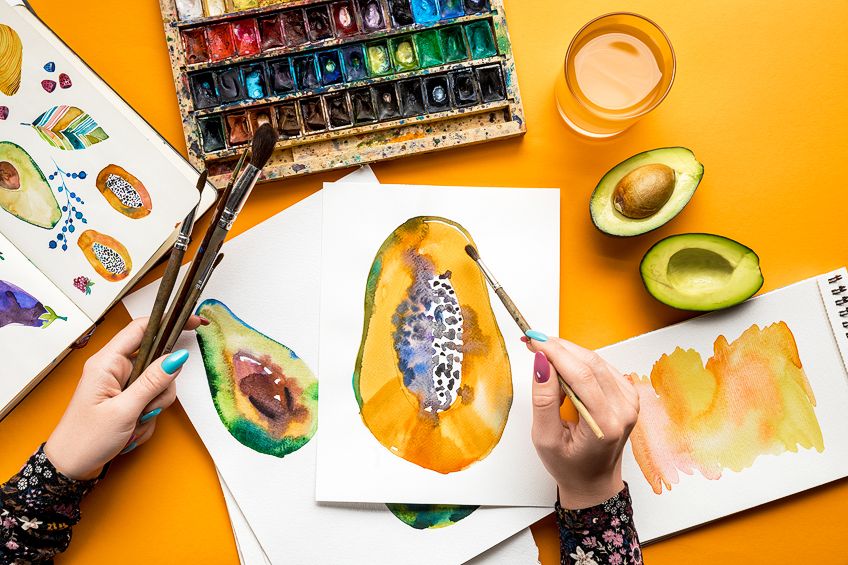
Watercolor Costs
You cannot waste watercolors like you might do with acrylics as you can re-use any dry paint again. They are more affordable, and the paint will last a fairly long time. Watercolors might be considered cheaper, but there are so many different brands, sizes, and types of both watercolors and acrylics that you will have to compare them to decide what is best.
Another advantage is that watercolor painting does not need any fancy equipment; all that is required are your paints, paper, and brushes.
Watercolor Lightfastness
Lightfastness is the ability of a paint to handle sunlight over time and retain its color. You have various measurements of lightfastness, which can either be excellent, good, or poor. Watercolors are not as good with lightfastness as acrylics and over time, if exposed to sunlight and not protected properly, the paint will begin to fade. Not only that, but the paper can also become brittle.
Creating Lighter Colors
In most cases, white paint is not what you use to lighten watercolors. Adding white to your watercolors will muddy the appearance and make it more opaque. White paint can be used if you want to create this effect, such as for highlights or other effects. So, it is up to you and what you want to do. However, the simplest method of lightening watercolors is to add more water.
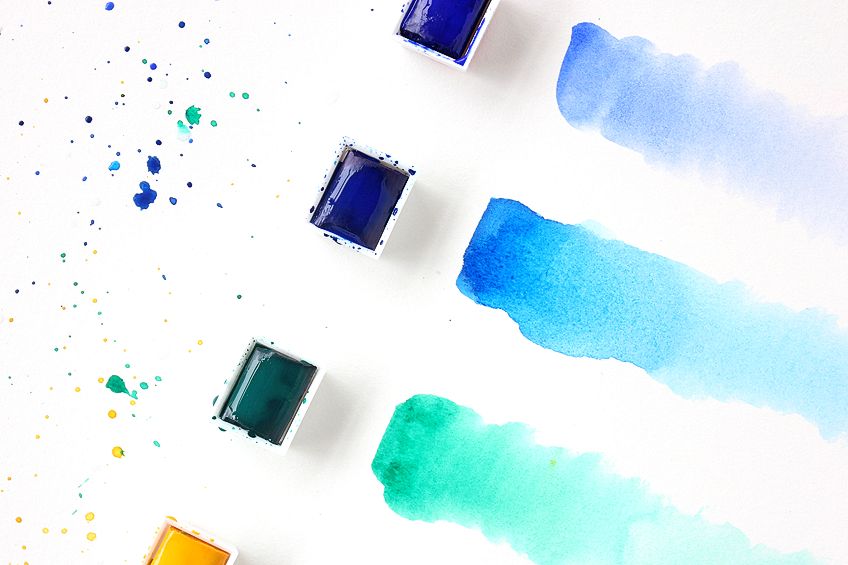
Watercolor Surfaces
Watercolors require a specific surface to be effective. This means you need to have a special watercolor paper to paint on. This paper is made for watercolors and absorbs the paint properly. You get different thicknesses of watercolor paper, where the thicker the paper, the more paint it can manage. When used on normal paper, watercolors usually bleed through and warp, and if too much water is used, the paper will begin to weaken. No priming is required for watercolor paper.
Watercolor Painting Approaches
When starting a watercolor painting, the best method is to start with lighter colors. So, you are working from lighter to darker paints. This is because it is difficult to undo the dark colors once they have been applied. Since watercolors are transparent, it is important to note that the lighter colors will also not show through if covered by darker paints. You also might want to leave some spaces open on the paper that they come through white.
It is also good to note that watercolors dry lighter, so try out your colors on another piece of paper to test the color first.
Watercolor art involves mostly layered painting and requires a good amount of control over the paint to achieve the final painting. This makes watercolor painting more challenging than acrylics. When your painting is done, the best option is to frame it under some glass and to keep it out of direct sunlight. You can also explore using different paint mediums to thicken the watercolors or create other effects.
Acrylic Art Paints
Acrylic paints contain pigment, acrylic resin, and binder. This plastic-based resin is man-made, unlike the natural binder used for watercolors. Acrylics are a little more versatile, as they can be watered down to imitate a watercolor effect.

Types of Acrylic Paints
Acrylic paints tend to come in jars, tubes, and bottles, of which there are a few different types available. You get your standard paint, different fluid types of acrylic paint, and paints that are re-workable. Many of the acrylic paints have different drying times, the longer the better for some. Medium-viscosity acrylic paint is similar to oil paint, while fluid acrylic paints are best used for glazing purposes.
Heavy-bodied paints are best utilized for brushwork and texturing, where heavy or thicker acrylic paints are perfect for impasto techniques.
You can also get pastes, gels, and other mediums that can alter the paint’s drying time, transparency, as well as the texture of the paint. This makes acrylic paints a great option for mixed-media art. Unlike watercolors, acrylics cannot be used again after they have dried. Acrylic paints will also not wash off clothes, so if kids are using acrylics, wearing an apron is advised.
Paint Transparency: Acrylics
Acrylic paints have a brighter appearance when compared to watercolors and are more opaque. You can thin acrylics until they become similar to watercolors and provide a transparent effect. However, even if you do thin the paint, it does tend to have more of a milky appearance.

Acrylic Drying Times and Clean-Up
Acrylic paints dry quickly so you need to work quickly to get things done. Generally, it takes around 10 to 20 minutes to dry. This makes blending and covering larger areas a little challenging. When it does dry, it dries to a flat, shiny appearance, and becomes darker in color than the wet paint. So, remember this point when mixing specific colors.
Brushes can be cleaned using water with some soap and should be done immediately once you have finished painting, as the paint will become difficult to remove once dry.
Acrylic Paint Costs
The acrylic paints do cost a little bit more than your watercolor paints but are less expensive than oil paints. Remember, acrylic paints dry fast, and you cannot use the paint again, so if any paint is left over, you will have to discard it, ultimately costing you more if you are not careful. However, acrylics are a bit more flexible as you can add water to the paint to imitate watercolors or use them as a paste for a more oil paint-like effect.
Acrylic Lightfastness
As mentioned, acrylics have a better rating when it comes to lightfastness when compared to watercolors or oil paints. Most acrylic paint products also usually display their lightfast rating on their labels.
Adding White Paint
White paint can be used with acrylics to lighten colors. You only need to add small amounts until you have the color you need. You want to make the exact amount of paint you need, as acrylics dry fast and any leftovers will have to be discarded. As with watercolors, white can also be used for creating effects like highlights with acrylics.
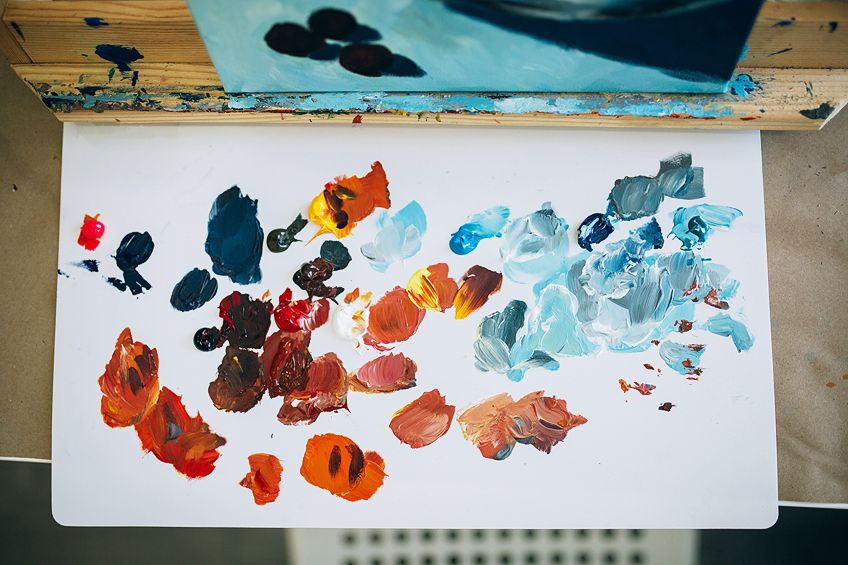
Acrylic Paint Surfaces
Acrylics are quite versatile in terms of what surfaces can be used, as you can paint on a variety of surfaces including canvas, paper, cardboard, wood, fabric, glass, plastic, and even metal. However, you will need to prime the surface before applying any acrylic paint. For example, using gesso on your canvas prior to painting, although this might not be necessary as many stretch canvases already come primed.
Acrylic Painting Approaches
To help give depth, acrylic paint can be applied using a range of dark to light colors. However, acrylic paints are quite versatile, so you could also try painting from light to dark. Just remember that these paints dry darker, so the wet paint color will not necessarily match the dry version. This can be a bit confusing when blending colors.
Acrylics can be diluted and used as a wash to mimic a watercolor effect that produces better results when painting from light to dark colors.
The thicker acrylics can also be used as oil paints and heavy-bodied acrylics are great for impasto techniques. Acrylic paints can also be applied more precisely and can be used for lettering if needed. You can also use other tools for a different effect, such as a palette knife.
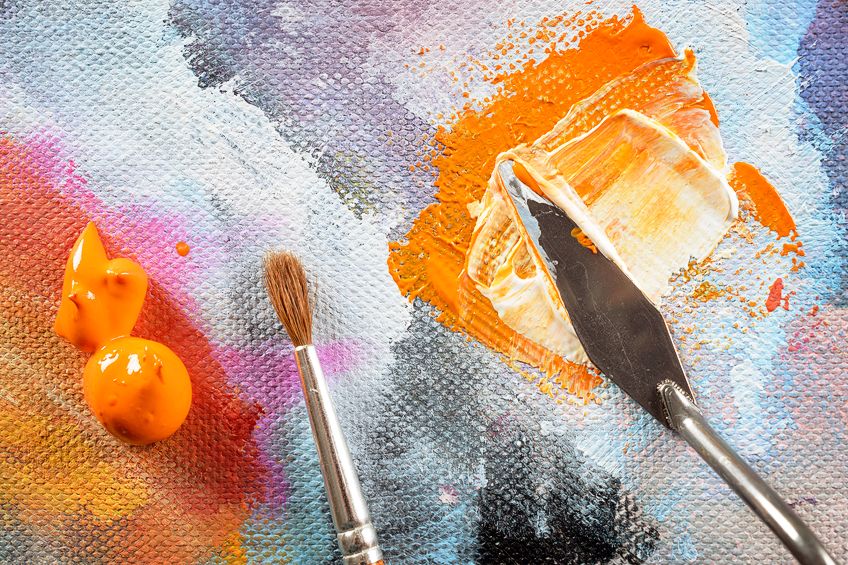
Acrylic vs. Watercolor Comparison Table
Below is a comparison table for easy reference in seeing the differences between watercolor and acrylic paints. Even though there are a few differences, both are amazing mediums to work with and can be used by beginners. However, when considering watercolor vs. acrylic for beginners, acrylics are a lot easier to use as you can fix mistakes and there are fewer elements to learn. Watercolors might be more difficult to learn as there are a lot of elements to consider and mistakes are very difficult if not impossible to correct.
So, all you have to do is discover your own style and preferences!
| Watercolor Paints | Acrylic Art Paints | |
| Binders | Natural gum arabic | Plastic acrylic resin |
| Types of Paint | Pans and tubes | Jars, tubes, bottles, and comes in different viscosities from fluid to heavy-bodied |
| Transparency | Transparent | Opaque |
| Drying Times | 5 to 15 minutes | 10 to 20 minutes |
| Clean-Up | Easy clean-up with water | Easy clean-up with soap and water immediately after use |
| Costs | Cheaper because it lasts longer | Affordable depending on quality and brand |
| Lightfastness | Will fade if exposed to direct sunlight | Better than watercolors, but always check the ratings |
| Creating Lighter Colors | Add more water, and avoid using white paint unless creating highlight effects | Use white paint |
| Painting Surfaces | Watercolor paper | Paper, canvas, wood, glass, fabric, metal, and more |
| Appearance When Dry | Dries lighter | Dries darker |
| Suitable for Beginners? | Can be used by beginners but is more difficult to learn and use | Best for beginners and easier to use |
Frequently Asked Questions
Is It Possible to Create a Watercolor Effect With Acrylics?
Yes, you can use acrylic paints to create a watercolor effect by thinning the acrylic paint with water or by adding a thinning medium.
Can You Paint Watercolor Over Acrylic?
Acrylic paint dries to a flexible type of plastic film that is non-porous, so applying watercolor over acrylic will not work. The watercolors will not adhere to the acrylic paint properly and will come off. On the other hand, you can create some nice paintings when using acrylic paint over wet watercolor paints.
Acrylic vs. Watercolor: Which Is Easier to Use?
Both are great mediums, but acrylic paints are easier to use, and any mistakes can be easily fixed. Watercolors can be difficult to learn and any mistakes you make are extremely difficult or impossible to fix. So, when it comes to watercolor vs. acrylic for beginners, acrylics might be the better option.
Can Acrylics Be Applied to Watercolor Paper?
There are quite a few differences between watercolor and acrylic paints; acrylics can be used on watercolor paper and a variety of other surfaces, whereas watercolor paints should only be used on watercolor paper for the best results.
Do Acrylics or Watercolors Dry Faster?
When comparing watercolor vs. acrylic paints, drying times can vary according to temperature, humidity, the brand of paint, and the type of surface you are painting on. Acrylic paints dry quickly within about 10 to 20 minutes. However, once dry, the paint cannot be re-wetted and used again. Watercolors also dry fast, within 5 to 15 minutes, but unlike acrylics, you can easily re-wet the paint and carry on working.
Matthew Matthysen is an educated multidisciplinary artist and illustrator. He successfully completed his art degree at the University of Witwatersrand in South Africa, majoring in art history and contemporary drawing. The focus of his thesis was to explore the philosophical implications of the macro and micro-universe on the human experience. Matthew uses diverse media, such as written and hands-on components, to explore various approaches that are on the border between philosophy and science.
Matthew organized various exhibitions before and during his years as a student and is still passionate about doing so today. He currently works as a freelance artist and writer in various fields. He also has a permanent position at a renowned online gallery (ArtGazette) where he produces various works on commission. As a freelance artist, he creates several series and successfully sells them to galleries and collectors. He loves to use his work and skills in various fields of interest.
Matthew has been creating drawing and painting tutorials since the relaunch in 2020. Through his involvement with artincontext.org, he has been able to deepen his knowledge of various painting mediums. For example, watercolor techniques, calligraphy and lately digital drawing, which is becoming more and more popular.
Learn more about Matthew Matthysen and the Art in Context Team.
Cite this Article
Matthew, Matthysen, “Watercolor vs. Acrylic – The Difference Between Watercolor and Acrylic.” Art in Context. August 22, 2021. URL: https://artincontext.org/watercolor-vs-acrylic/
Matthysen, M. (2021, 22 August). Watercolor vs. Acrylic – The Difference Between Watercolor and Acrylic. Art in Context. https://artincontext.org/watercolor-vs-acrylic/
Matthysen, Matthew. “Watercolor vs. Acrylic – The Difference Between Watercolor and Acrylic.” Art in Context, August 22, 2021. https://artincontext.org/watercolor-vs-acrylic/.







